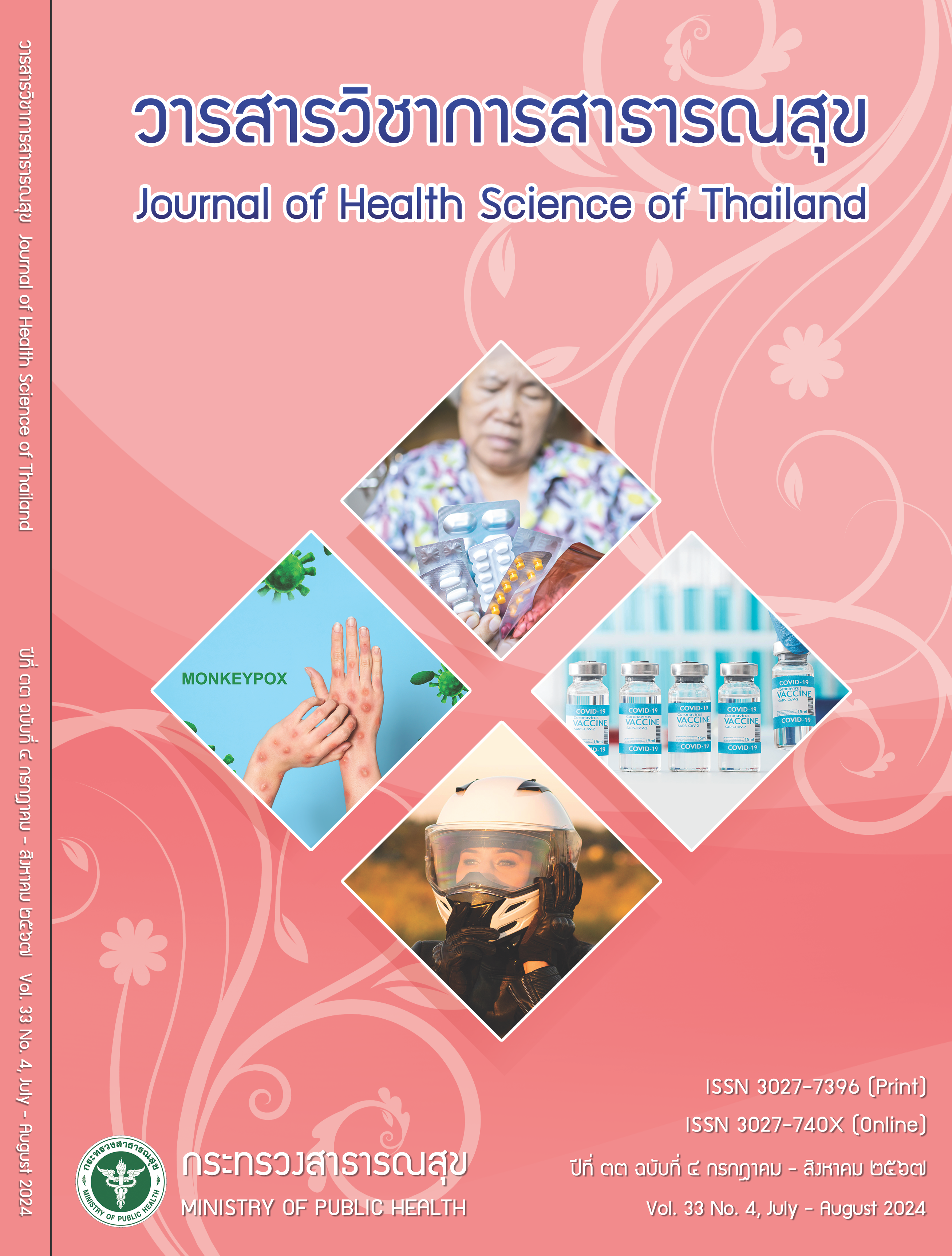Costs for COVID-19 inpatients in Thailand: a case study of Ministry of Public Health Hospitals
Keywords:
COVID-19, inpatient costs, hospital costsAbstract
The objectives of this study were to analyze hospital costs for inpatients with COVID-19 in fiscal year 2021 and analyze predictive factor of the cost of inpatients with COVID-19. The costs were from the provider’s perspective and calculated using standard top-down and bottom-up methods by the HSCE program. The data were obtained from 21 voluntary hospitals under the Ministry of Public Health (MOPH) including 9 of regional hospitals, 8 of general hospitals and 4 community hospitals. Inclusion criteria for COVID-19 were inpatients with diagnoses U07.1, U07.2, B97.2 and then grouped into Thai Diagnosis Related Group (DRG) via TDRG version 6.3. The COVID-19 inpatients were classified by 6 DRG groups. Prior to the analysis, abnormal cost data were excluded, resulting in 87,145 cases for analysis. The analysis used statistical descriptive analysis e.g. percent, arithmetic mean, standard deviation (SD), median, and multiple regression analysis as statistical predictive analysis. The results showed that most of inpatients with COVID-19 were in regional hospitals, 68.6%. Overall, patients with COVID-19 spent an average of 11 days in hospital (SD=4.1). The average age of the patients was 35.1 years. The top three most frequent DRG were observation DRG group, 49,225 cases (56.5%) followed by pneumonia DRG group 21,385 cases (24.5%) and respiratory DRG group 12,271 cases (14.1%). The average and median cost per case were 22,216 baht (SD=72,135) and 13,847 baht. The highest average cost was 25,653 baht per case (SD=72,135) at general hospitals, 21,068 baht (SD=20,276) at regional hospitals, and 15,984 baht (SD=13,968) at community hospitals. The average and median costs for patients with severe DRG group were 72,327 baht per case (SD=54,027) and 61,326 baht. The average and median costs for patients with pneumonia DRG group were 31,259 baht per case (SD=46,035) and 21,900 baht. The average and median costs for patients with observation DRG group were 17,022 baht (SD=39,536) and 11,437 baht. The predictive factors of the costs of COVID-19 inpatient were hospital size, severe DRG group, age, medical supply costs, room and food costs and nursing costs. These factors were able to explain the cost of COVID-19 inpatients at 80.9% with statistical significance (p<0.001). The results of predictive factors of costs for taking care of inpatients with COVID-19 found that: (1) the general hospital would see a 28.0% increase in cost comparedto the community hospitals; (2) severe DRG group an 86.0% compared to the observation DRG group; (3) a 1 year increase in age would result in a 0.3% increase; and (4) for service factors, it was found that when only one of medical supply costs, room and food costs, and nursing cost was increasing by 1%, it would result in increasing costs 0.1%, 0.3% and 0.3% respectively. Aside from knowing the actual cost of services, the benefits from this study were used as information for requesting COVID-19 budget allocations as well as planning hospital resources. Further, the impact of factors affecting service costs could be applied to develop service efficiency to reduce the cost of providing services to COVID-19 inpatients or other infectious diseases.
Downloads
References
ปิยะธิดา หาญสมบูรณ์. ค่ารักษาพยาบาลโรคโควิด-19. วารสารกรมการแพทย์ 2564;46(2):5-9.
กรมควบคุมโรค. สถานการณ์ผู้ติดเชื้อ COVID-19 อัพเดท รายวัน 2021 [อินเทอร์เน็ต]. [สืบค้นเมื่อ26 ต.ค. 2564]. แหล่งข้อมูล: https://ddc.moph.go.th/viralpneumonia/.
กรมควบคุมโรค. สถานการณ์ ผู้เสียชีวิตจากเชื้อCOVID-19 ในประเทศไทย 2021 [อินเทอร์เน็ต]. [สืบค้นเมื่อ 26 ต.ค. 2564]. แหล่งข้อมูล: https://ddc.moph.go.th/covid19-dashboard/?dashboard=death-statistics.
กรมควบคุมโรค. แนวทางการเฝ้าระวังและสอบสวนโรคติดเชื้อไวรัสโคโรนา 2019 [อินเทอร์เน็ต]. [สืบค้นเมื่อ 11 ต.ค. 2564]. กรมควบคุมโรค; 2564 แหล่งข้อมูล: https://ddc.moph.go.th/viralpneumonia/file/g_srrt/g_srrt_110864. pdf
กรมวิทยาศาสตร์การแพทย์. คู่มือการตรวจวินิจฉัยโรคติดเชื้อไวรัสโคโรนา 2019 ทางห้องปฏิบัติการ SARS-COV-2 [อินเทอร์เน็ต]. [สืบค้นเมื่อ11 ส.ค. 2564]. แหล่งข้อมูล: https://nih.dmsc.moph.go.th/data/data/covid/ COVID19.pdf
สำนักสารนิเทศ สำนักงานปลัดกระทรวงสาธารณสุข. สธ.เผย ยาและเวชภัณฑ์รองรับโควิด-19 มีเพียงพอจัดหา “ยาฟาวิพิราเวียร์” 16 ล้านเม็ด ก.ค.นี้[อินเทอร์เน็ต]. [สืบค้นเมื่อ11 ส.ค. 2564]. แหล่งข้อมูล: https://pr.moph.go.th/?url =pr/detail/2/04/161248/
กรมการแพทย์. แนวทางการจัดบริการผู้ป่วยสำหรับสถานพยาบาลกรณี โรคติดเชื้อไวรัสโคโรนา 2019 เป็นโรคติดต่อที่ต้องเฝ้าระวัง ฉบับวันที่ 29 กันยายน 2565 [อินเทอร์เน็ต]. [สืบค้นเมื่อ 1 ต.ค. 2566]. แหล่งข้อมูล: https://nih.dmsc. moph.go.th/data/data/covid/COVID19.pdf
สำนักพัฒนากลุ่มโรคร่วมไทย สถาบันวิจัยระบบสาธารณสุข. รายงานผลการศึกษาโครงการการประเมินผลกระทบของ โควิด-19 ต่อต้นทุนการดำเนินงานของโรงพยาบาลรัฐ. กรุงเทพมหานคร: สำนักพัฒนากลุ่มโรคร่วมไทย สถาบันวิจัย ระบบสาธารณสุข; 2564.
อรทัย เขียวเจริญ, ชัยโรจน์ ซึงสนธิพร, ธันวา ขัติยศ, ชัชชน ประเสริฐวรกุล, ทยาภา ศรีศิริอนันต์, พงษ์ลัดดา หล่ำพู่. วิธีคาดประมาณต้นทุน 6 ขั้นตอนในการศึกษาต้นทุนรายโรค ระยะ ที่1. สรรพสาร สมสส (HISPA Compendium) 2566;1(2):12-27.
อรทัย เขียวเจริญ, ชัยโรจน์ ซึงสนธิพร, ธันวา ขัติยศ, เยาวลักษณ ์ แหวนวงษ์, ชลธิดา ใบม่วง, ศุภสิทธิ์ พรรณารุโณทัย. วิธีวิเคราะห์ต้นทุนรายโรคสำหรับประเทศไทย วิธีต้นทุนจุลภาค. วารสารวิจัยระบบสาธารณสุข2563;14(2): 156-174.
สำนักพัฒนากลุ่มโรคร่วมไทย สถาบันวิจัยระบบสาธารณสุข. โปรแกรม HSCE (HealthCare Service Cost Estimation). กรุงเทพมหานคร: กรมทรัพย์สินทางปัญญา กระทรวงพาณิชย์; 2566.
สำนักพัฒนากลุ่มโรคร่วมไทย สถาบันวิจัยระบบสาธารณสุข. การให้รหัสโรค กรณี COVID-19 และวัคซีน COVID-19[อินเทอร์เน็ต].[สืบค้นเมื่อ27ต.ค.2564].แหล่งข้อมูล: https://tcmc.or.th/main/phocadownload/Covid19Code/ code4covid-19.pdf
สำนักพัฒนากลุ่มโรคร่วมไทย สถาบันวิจัยระบบสาธารณสุข. รายงานผลการศึกษาฉบับสมบูรณ์ การวิเคราะห์ข้อมูลเพื่อจัดทำข้อเสนอทางเลือกในการพัฒนากลไกการจ่ายเงินของระบบบริการตามสิทธิประโยชน์ผู้ป่วยใน. นนทบุรี: สำนักพัฒนากลุ่มโรคร่วมไทย สถาบันวิจัยระบบสาธารณสุข; 2564.
อรทัย เขียวเจริญ, ชัชชน ประเสริฐวรกุล, เฌอมาณัฎฐ์ ศรีวงค์ชัย, ธันวา ขัติยศ, ทยาภา ศรีศิริอนันต์, พงษ์ลัดดา หล่ำพู่, et al. ต้นทุนต่อหน่วยผู้ป่วยนอกและผู้ป่วยในจากการ ศึกษาต้นทุนรายโรคระยะที่1. สรรพสาร สมสส (HISPA Compendium) 2566;1(6):77-99.
สำนักพัฒนากลุ่มโรคร่วมไทย สถาบันวิจัยระบบสาธารณสุข. ผลการวิเคราะห์ต้นทุนรายโรค ระยะที่1 ปีที่ 4. กรุงเทพมหานคร: สำนักพัฒนากลุ่มโรคร่วมไทย; 2564.
อรทัย เขียวเจริญ, ธันวา ขัติยศ, ชลธิดา ใบม่วง, ชัยโรจน์ ซึงสนธิพร, เยาวลักษณ ์ แหวนวงษ์, ศุภสิทธิ ์พรรณารุโณทัย.วิธีวิเคราะห์ต้นทุนรายโรคสำหรับประเทศไทย:วิธีต้นทุนจุลภาค. วารสารวิจัยระบบสาธารณสุข 2563;14(2):156 - 174.
กรมบัญชีกลาง. หลักเกณฑ์และอัตราค่ารักษาพยาบาลประเภทผู้ป่วยนอกและผู้ป่วยในสถานพยาบาลของทางราชการกรณีผู้มีสิทธิหรือบุคคลในครอบครัวเสี่ยงหรือติดเชื้อไวรัสโคโรนา 2019 หรือโรคโควิด-19. กรุงเทพมหานคร: กรมบัญชีกลาง; 2565.
สำนักงานประกันสังคม. ประกาศคณะกรรมการการแพทย์ ตามพระราชบัญญัติประกันสังคม เรื่อง หลักเกณฑ ์ และอัตราค่าบริการทางการแพทย์กรณีโรคติดเชื้อไวรัสโคโรนา 2019 หรือโรคโควิด-19. ราชกิจจานุเบกษา เล่มที่139, ตอนพิเศษ 133 (ลงวันที่13 มิถุนายน 2565).
สำนักงานประกันสังคม.หลักเกณฑ์และอัตราค่าบริการทางการแพทย์กรณีโรคติดเชื้อไวรัสโคโรนา 2019 หรือโรคโควิด-19 (coronavirus disease 2019 (COVID-19)) สำหรับการดูแลรักษาในที่พักระหว่างรอเข้ารับการรักษาแบบผู้ป่วยในโรงพยาบาล (home isolation) และการดูแลรักษา การแยกกักในชุมชน (community isolation), (2565). นนทบุรี: สำนักงานประกันสังคม; 2565.
สำนักงานหลักประกันสุขภาพแห่งชาติ. แจ้งปรับปรุงหลักเกณฑ์ เงื่อนไข และอัตราจ่ายการให้บริการโรค
โควิด-19 ใน ระบบหลักประกันสุขภาพแห่งชาติ ปีงบประมาณ พ.ศ.2565. กรุงเทพมหานคร: สำนักงานหลักประกันสุขภาพแห่งชาติ; 2565.
Kumar RK. Technology and healthcare costs. Annals of Pediatric Cardiology 2011;4(1):84-6.
Monegain B. Technology helps drive high cost of U.S. healthcare. Healthcare IT News [Internet]. 2012 [cited 2021 Oct 17]. Available from: https://www.healthca-reitnews.com/news/technology-helps-drive-high-cost-us-healthcare
McCabe JJ, Cournane S, Byrne D, Conway R, O’Rior¬dan D, Silke B. Age and the economics of an emergen¬cy medical admission—what factors determine costs? QJM: An International Journal of Medicine 2017;110(2): 83–8.
Rashidi B, Kobewka DM, Campbell DJT, Forster AJ, Ronksley PE. Clinical factors contributing to high cost hospitalizations in a Canadian tertiary care centre. BMC Health Services Research 2017;17(1):777.
Downloads
Published
How to Cite
Issue
Section
License
Copyright (c) 2024 Ministry of Public Health

This work is licensed under a Creative Commons Attribution-NonCommercial-NoDerivatives 4.0 International License.







